Embark on the adventure of a lifetime with our 7-day Kilimanjaro Climb via the Shira Route. This iconic trek is designed for thrill-seekers and nature enthusiasts, offering a unique and awe-inspiring journey to the summit of Africa’s tallest peak. The Shira Route presents a less-trodden path, promising stunning landscapes, diverse ecosystems, and an unforgettable experience. As you ascend through various climatic zones, each day brings new challenges and breathtaking vistas, making this climb an ideal choice for those seeking a truly immersive and rewarding Kilimanjaro experience. This less-traveled path to Kilimanjaro’s summit offers intrepid adventurers a unique perspective, both in terms of geological wonders and the cultural tapestry that has unfolded over the centuries.
Understand the Shira Route on This 7-Day Kilimanjaro Climb
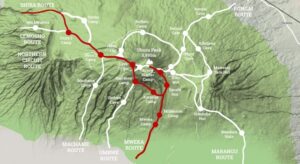
The Shira Route, one of Kilimanjaro’s lesser-known pathways to the summit, boasts a rich history intertwined with exploring this iconic peak. Originally used as a descent route, the Shira Plateau, through which the Shira Route traverses, has become a favored ascent path in modern times. This route offers trekkers a historical perspective, as it follows ancient trails used by indigenous people and early explorers. Its evolution into a key route for Kilimanjaro climbers showcases a legacy of human interaction with this awe-inspiring mountain.
The journey begins in the verdant rainforests, home to an array of flora and fauna, setting the stage for an immersive experience. As trekkers ascend, the landscape transitions into the otherworldly Shira Plateau, a high-altitude desert with vast expanses and panoramic views. This unique ecological diversity defines the Shira Route, allowing trekkers to witness Kilimanjaro’s changing ecosystems firsthand.
The Shira Plateau: A Remnant of Kilimanjaro’s Volcanic Legacy
The journey through the Shira Route commences with an awe-inspiring exploration of the Shira Plateau. This expansive high-altitude plateau is a geological relic, showcasing the vestiges of Kilimanjaro’s volcanic past. The Shira Plateau, once an independent peak, has now fused with Kilimanjaro’s main summit, and its stark beauty provides a stark contrast to the lush rainforests below.
Ancient Trails and Geological Shifts
As trekkers ascend through the various ecological zones, they tread upon paths that have witnessed the footprints of ancient tribes and explorers. The Shira Route serves as a living testimony to the geological shifts that have shaped Kilimanjaro’s landscape over millennia. Each step on this historic route echoes with the whispers of the past, creating a profound connection between the modern-day adventurer and the geological forces that have sculpted these colossal slopes.
Embarking on the Shira Route is akin to stepping into a botanical wonderland. The trek begins in the verdant rainforests, where colossal trees and vibrant flora create a sensory feast. As altitude increases, the landscape transforms into an alpine desert, dotted with otherworldly plants such as the giant Senecio and lobelias. This botanical diversity along the Shira Route showcases Kilimanjaro’s remarkable adaptability to diverse climates.
Chronicles of Kilimanjaro’s Rich Cultural History
Kilimanjaro, with its imposing presence, has been a focal point for indigenous tribes such as the Chagga and Maasai. The Shira Route, though less frequented, is not devoid of the cultural significance woven into Kilimanjaro’s history. Local guides share tales of ancient rituals, ceremonies, and the spiritual importance Kilimanjaro holds for these tribes. The route provides a glimpse into the symbiotic relationship between the mountain and its people.
The Shira Route is not only a botanical spectacle but also a haven for wildlife enthusiasts. Trekkers may encounter various species of monkeys, birds, and unique insects as they ascend through the varying ecological zones. Kilimanjaro’s isolation has fostered the evolution of distinct flora and fauna, making each moment on the Shira Route a potential wildlife sighting adventure.
Choose the Shira Route for your Kilimanjaro ascent, and you’re opting for an exclusive adventure. Crafted for those who seek the extraordinary, this 7-day Kilimanjaro Climb via Shira Route offers unique Kilimanjaro experiences and personalized Shira Route adventures, ensuring that your climb is as distinctive as the iconic landscapes you traverse.
Day 1: Arival
Arrive at the Kilimanjaro International Airport. You will be met at the airport and transferred to the Springlands Hotel in Moshi for your overnight.
- Meals: No Meals Included.
Day 2: Shira Camp 1 Full Board
After breakfast and a briefing from your guide, leave Moshi and drive for several hours to the Shira Gate on the western side of Kilimanjaro, register with the national park. Begin hiking, and enter the rainforest immediately. Your walk through the rainforest is on a winding muddy trail up a ridge. At these lower elevations, it can be wet and muddy, so gaiters and trekking poles will help. Stop halfway for lunch, and reach the Shira Camp in the afternoon.
- Unpack, rest, and have some tea or coffee.
- Dinner is served during the early evening at 7 PM.
Day 3: Shira Hut Full Board
After breakfast, you will hike east up a steepening path above the highest vegetation toward Kilimanjaro’s looming mass. After several hours, you walk through a rocky landscape to reach the prominent landmark called Lava Tower at 4,630 m/15,190 ft. This chunky remnant of Kilimanjaro’s earlier volcanic activity is several hundred feet high, and the trail passes right below it. For extra credit, the sure-footed can scramble to the top of the tower. After a lunch stop near Lava Tower, descend for 2 hours below the lower cliffs of the Western Breach and Breach Wall to Barranco Camp at 3,950 m/12,960 ft. There are numerous photo opportunities on this hike, especially if the walls are festooned with ice. Barranco Camp is in a valley below the Breach and Great Barranco Walls, which should provide you with a memorable sunset while you wait for your dinner. On this day, be careful to notice any signs of altitude sickness.
Day 4: Barranco Hut Full Board
After breakfast, we continue up a steep ridge to the great Barranco Wall, and then you climb this imposing obstacle, which turns out to be easier than it looks.
Topping out just below the Heim Glacier, you can now appreciate just how beautiful Kilimanjaro really is. With Kibo’s glaciers soaring overhead, you descend into the lush Karanga Valley to the Karanga Valley campsite. From the camp, you can look east and see the jagged peaks of Mawenzi jutting into the African sky. After a hot lunch in camp, your afternoon is at leisure for resting or exploring. After two long days, this short day is very important for your acclimatization, since your summit push is about to start.
Day 5: Barafu Hut Full Board
In the morning, you hike east over intervening ridges and valleys to join the Mweka Route, which will be your descent route. Turn left toward the mountain and hike up the ridge through a sparse landscape for another hour to the Barafu Hut where you will receive a hot lunch. The last water on the route is in the Karanga Valley; there is no water at Barafu Camp, even though Barafu is the Swahili word for “ice.”The famous snows of Kilimanjaro are far above Barafu Camp near the summit of the mountain. Your tent will be pitched on a narrow, stony, wind-swept ridge, so make sure that you familiarize yourself with the terrain before dark to avoid any accidents. Prepare your equipment and warm clothing for your summit climb, and drink a lot of fluids. After an early dinner, go to bed for a few hours of precious sleep.
Day 6: Summit Down to Mweka Camp Full Board
You will rise around 11:30 PM, and after some steaming tea and biscuits, you shuffle off into the night. Your 6-hour climb northwest up through heavy scree between the Rebmann and Ratzel glaciers to Stella Point on the crater rim is the most challenging part of the route for most climbers. At Stella Point (5,685 m/18,650 ft) you stop for a short rest and a chance to see a supremely sanguine sunrise. At Stella Point, you join the top part of the Marangu Route but do not stop here too long, as it will be extremely difficult to start again due to cold and fatigue. Depending on the season and recent storms, you may encounter snow on your remaining hike along the rim to Uhuru Peak. On the summit, you can enjoy your accomplishments and know that you are creating a day that you will remember for the rest of your life. After your 3-hour descent from the summit back to Barafu Camp, you will have a well-earned but short rest. Collect your gear, and hike down a rock and scree path into the moorland and eventually into the forest to Mweka Camp (3,100 m/10,170 ft). This camp is in the upper forest, so you can expect mist or rain in the late afternoon. Dinner and washing water will be prepared, and the camp office sells drinking water, soft drinks, chocolates, and beer!
Day 7:Trek Millennium Camp (3790m) to Mweka Gate (1630m)
A gentle trek takes us down through the rainforest to Mweka Gate, where we complete park formalities and receive certificates, which you can hang up with pride! we are then met by our vehicles and return to the hotel in Moshi, where you can treat yourself to a welcome shower (and a cold beer or two!) before our big celebration. Overnight at the Weru Weru River Lodge (or alternative)
- Distance covered: 12.1km / 7.5mi
- time taken: 6 hours
- Meals: Breakfast and lunch Included.
Day 8: Depart To Tanzania
After a well-deserved breakfast, it is a short, scenic, 3-hour hike back to the park gate. Don’t give your porters any tips until you and all your gear have reached the gate safely, but do remember to tip your staff at the gate. At Mweka Gate, you can sign your name and add details to a register. This is also where successful climbers receive their summit certificates. Climbers who reach Stella Point are issued green certificates and those who reach Uhuru, Peak receive gold certificates. From the Mweka Gate, you will continue down to the Mweka Village, possibly a muddy, 3 km, 1-hour hike if the road is too muddy for vehicles. In the Mweka Village, you will be served a delicious hot lunch after which you are driven back to Moshi for an overdue hot shower and a comfortable night in our Spring Lands Hotel.
Day 9: Depart To Tanzania
After saying bye to our team in operation you need a Private departure transfer which is included from Arusha to Kilimanjaro International Airport (JRO).
The Price Includes
- Hotel lodging the night before and the night after the climb (dinner and breakfast included) (double occupancy).
- Quality, waterproof, four-season private mountain sleeping tents:
- Professional, experienced, mountain guides:
- Two nights hotel in Arusha
- All Park fees
- Rescue fees
- All meals while on the Mountain
- Arrival and Departure transfers
- Guides, Porters, cook salaries and park fees
- Quality Mess tents with table and chairs:
- Large portions of fresh, healthy, nutritious food:
- Clean, purified drinking water:
- Private, portable chemical flush toilets:
- Crisis management and safety procedures:
- Fair and ethical treatment of porters:
- Walking Poles:
- Sleeping Mattress
The Price Does Not Include
- Tanzania Visa: $50 per person on arrival
- Personal Expenses (e.g. laundry, telephone, beverages, etc.)
- Meals not listed above
- Optional Tours (short safari after your climb etc)
- Tips and any items of a personal nature
- Flying Doctor Service
- Summit Emergency Oxygen
- Pulse Oximeters:


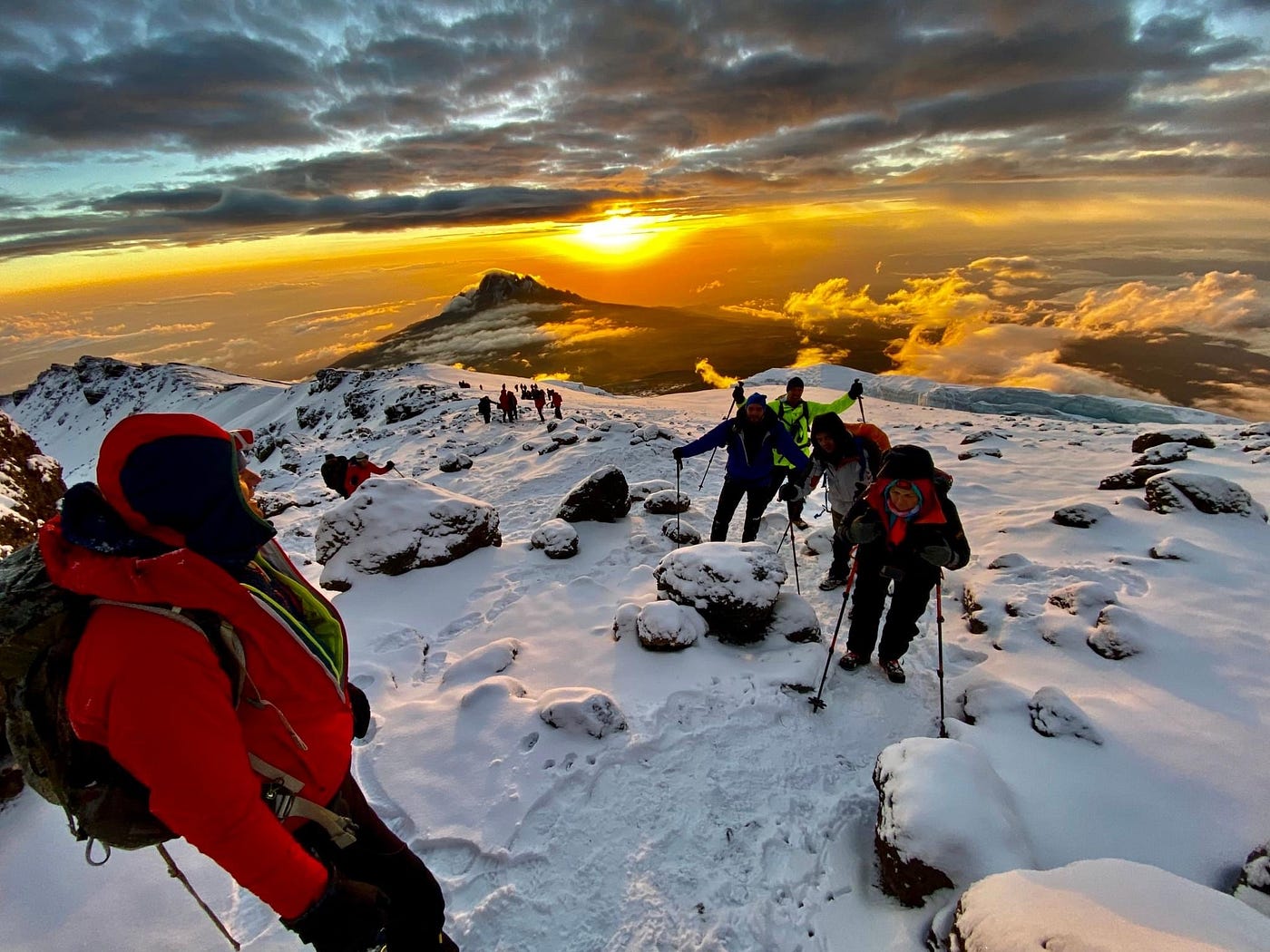
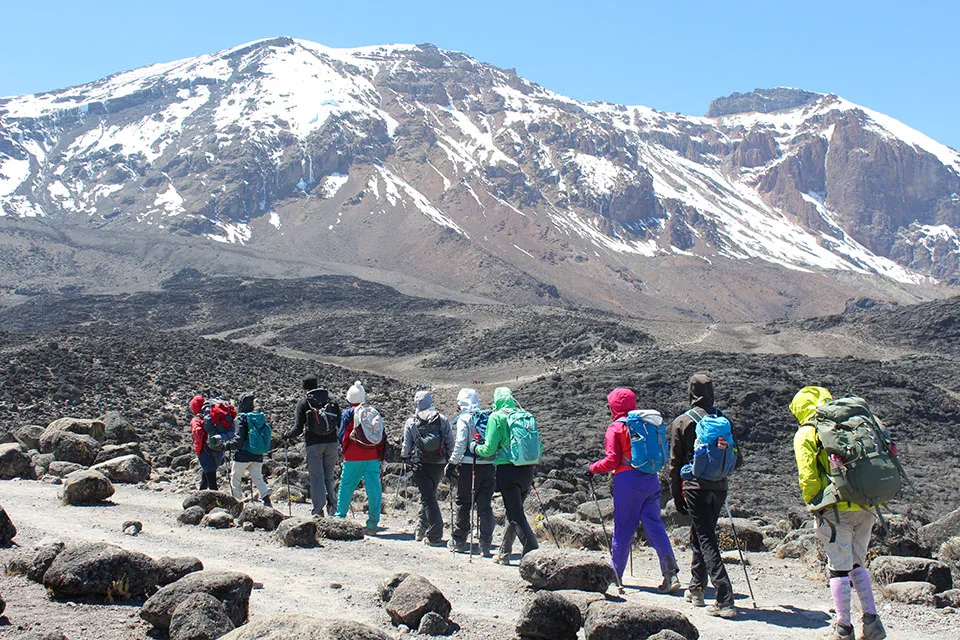
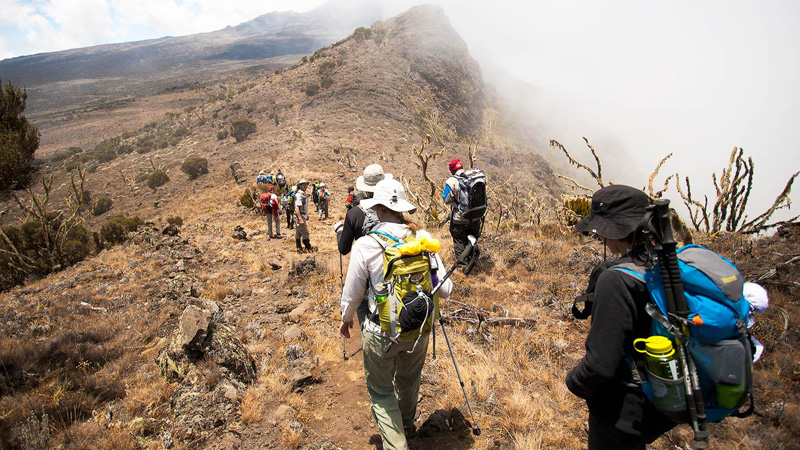
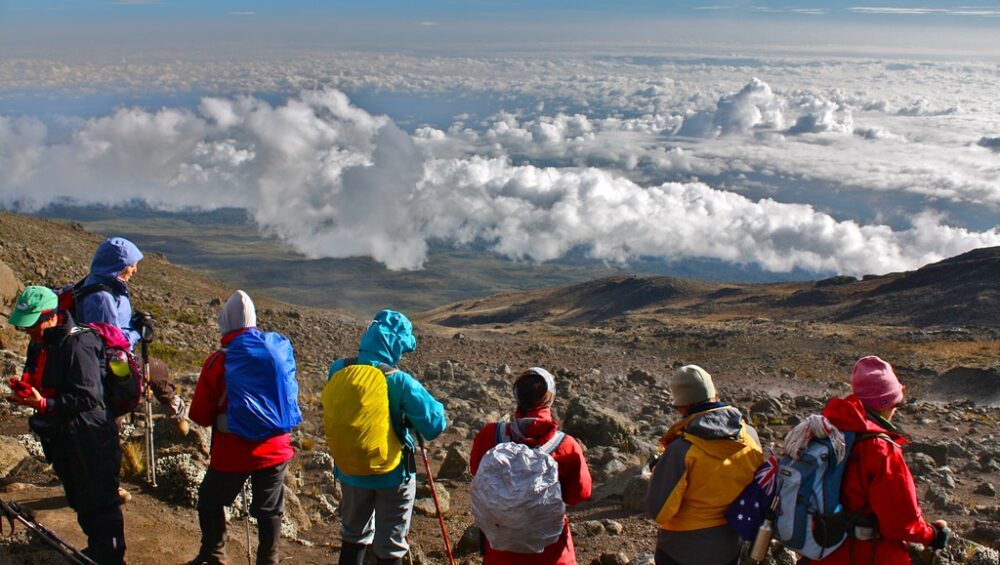
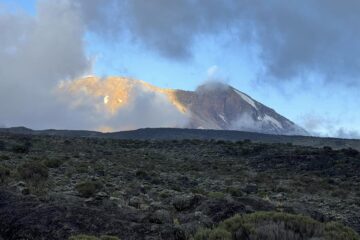
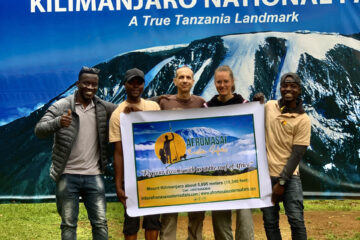
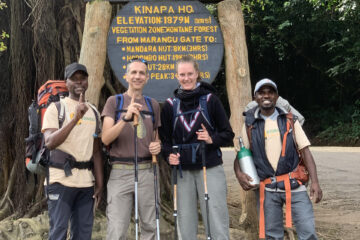
Tour Reviews
There are no reviews yet.
Leave a Review